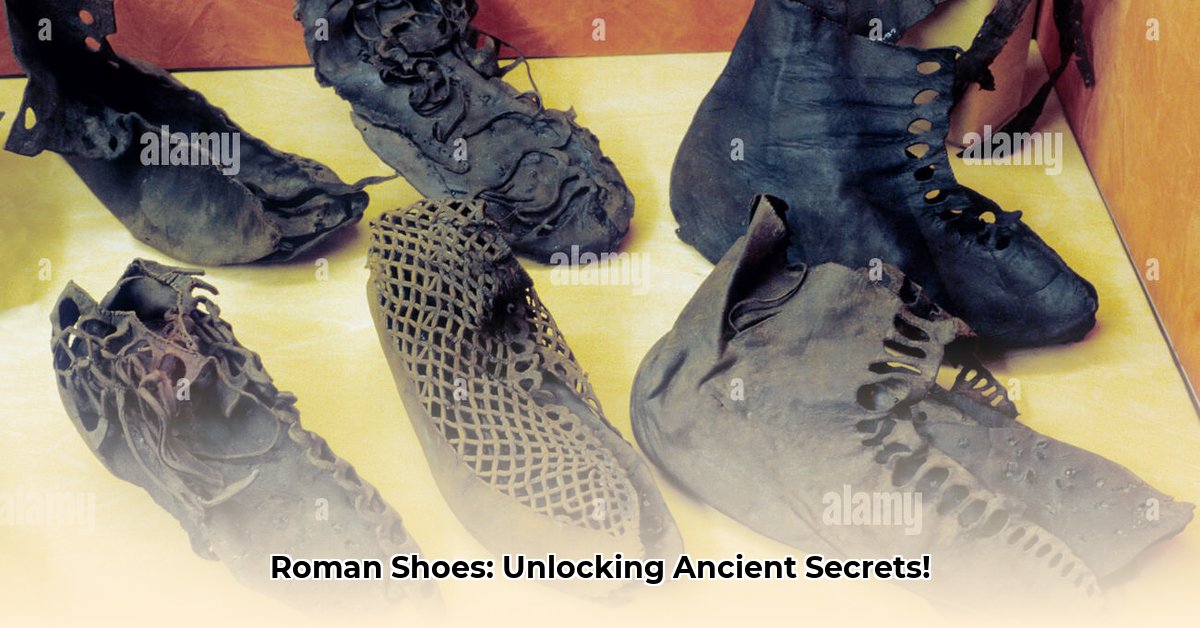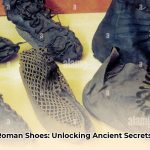Imagine stepping back in time, not just to an empire of grand architecture and legendary battles, but to the very ground its citizens walked. Roman footwear, far from being mere utilitarian coverings, served as powerful symbols of military prowess, social standing, and regional identity. Learn more about the soldier’s uniform worn with the caligae. Today, archaeological digs continue to unearth these fascinating artifacts, none more intriguing than the exceptionally large Roman caligae found at Magna, an ancient fort in England. These discoveries are not just remnants; they are vital clues, offering profound insights into the daily lives, adaptations, and diverse populations of ancient Rome.
The Caligae Story: The Enduring Marching Boots of Rome
The Roman legionary’s iconic caligae (Latin; singular: caliga) were much more than simple sandals; they were heavy-duty, hobnailed military sandal-boots, purpose-built for the grueling demands of conquest and constant marching. Crafted from a single piece of high-quality ox or cowhide, these openwork boots featured thick, sturdy soles studded with numerous iron hobnails. These strategically placed hobnails provided unparalleled grip and support, much like the precision design of modern sports shoes, ensuring stability across varied terrains—from slippery mountain passes to muddy battlefields.
The caligae were instrumental in the Roman army’s ability to maintain its relentless pace across vast territories spanning Europe, North Africa, and the Middle East. Beyond their practical function, the rhythmic, thunderous sound of thousands of hobnailed caligae on the march must have been a deeply intimidating auditory symbol of Rome’s military might, designed to strike fear into the hearts of their adversaries. This constant daily wear highlights the rigorous demands placed on the Roman legionaries, making durable footwear a non-negotiable necessity. Historical accounts underscore their significance; the historian Josephus, for instance, recounts a Roman centurion slipping on the marble floor of the Temple of Jerusalem due to his caliga during a chaotic attack. Furthermore, Jewish sages of Roman Judea even limited their community’s use of caligae after a tragic incident where many Jews in hiding mistook the sound for approaching Roman soldiers, leading to a fatal stampede.
While ideal for warm Mediterranean climates, allowing for coolness and ventilation, the open design of caligae presented challenges in colder, wetter regions like northern Britain. By the late 2nd century AD, in favor of more enclosed civilian-style “closed boots” (carbatinae), their use diminished in these northern outposts. By the late 4th century, this shift towards closed footwear became prevalent throughout the Roman Empire, indicating an evolution in military and civilian practicality.
Beyond the Battlefield: Footwear as a Social Canvas
In ancient Rome, shoes were a powerful, silent language, communicating a wearer’s identity, wealth, and place within the intricate social hierarchy. The Romans were pioneers in shoe-making technology, notably introducing vegetal tanning to Northwestern Europe. This revolutionary process, treating animal skins with plant extracts, resulted in chemically stable, water-resistant leather—a significant leap from earlier methods of oiling or smoking hides. This innovation, likely driven by the Roman army’s immense supply requirements, ensured the durability and widespread availability of leather for diverse footwear.
The range of styles and materials explicitly indicated social status:
- Calcei: These soft leather, closed-toe shoes completely covered the foot and were fastened with thongs. They were the exclusive mark of a free Roman citizen and were considered appropriate wear only with the toga, strictly forbidden for enslaved individuals. Early versions, calcei repandi, sometimes featured distinctive pointed, upward-curving toes.
- Calceus Senatorius: Senators, the apex of Roman society, wore a special variant of the calcei. Made of black leather, these distinguished shoes featured four prominent straps (corrigiae) and, most notably, were adorned with a crescent-shaped emblem on the top, unmistakably marking the wearer as part of the ruling elite. Similar patrician shoes, the calceus mulleus, were even more costly, made of red leather, and were secured with hooks and straps around the ankle.
- Soleae and Sandalia: These were generic terms for house sandals, typically worn with a simple tunic. They were deemed inappropriate for formal attire like the toga, and Romans would often remove them before reclining for a feast, requesting them back when finished.
- Socci: Light, flat-soled slippers made of leather or cloth, designed for everyday wear and popular among both men and women.
- Pero: A robust boot made of rawhide, typically worn in wet weather, highlighting the adaptation of footwear to environmental conditions.
- Simple Sandals: Often the footwear of choice for enslaved people and the lower classes, serving basic protective functions without the elaborate social embellishments of the elite.
The Romans were also innovators in the concept of owning multiple pairs of shoes for different occasions, a practice that echoes our modern wardrobes. Imagine the visual impact in a crowded forum, where every step and every shoe communicated power, prestige, or servitude.
The Magna Enigma: A Puzzle of Prodigious Proportions
At Magna, a Roman fort along the rugged Hadrian’s Wall in northern England, archaeologists have unearthed an intriguing anomaly: an unusually high proportion of ancient Roman shoes that are remarkably large, frequently exceeding modern men’s shoe size 11.8 (US). This phenomenon is particularly striking when compared to the nearby Roman fort of Vindolanda, where only about 0.4 percent of measurable shoes were this size, while at Magna, the figure is closer to 25 percent. This raises a compelling archaeological mystery: who wore these colossal caligae, and why were they so large?
Several theories attempt to unravel this puzzling size discrepancy, each offering a potential glimpse into the lives of those stationed on Rome’s northern frontier:
- Medical Necessity Hypothesis: Some researchers propose that the wearers might have suffered from medical conditions leading to swollen feet or required extra space for bandages due to injuries sustained in a demanding military life. Such conditions would necessitate larger footwear than average.
- Winter Warmth Theory: Given the notoriously cold, damp English winters, these substantial shoes might have been specifically designed to accommodate multiple layers of thick socks or insulating materials, such as raw wool wadding, providing crucial protection against the biting elements. Historical records support this, with documented instances of warm undergarments and socks being supplied to troops stationed in the region.
- Regional Population Differences: Another compelling possibility suggests that the population garrisoned at Magna, perhaps due originating from a specific ethnic group or recruitment source, simply had larger average foot sizes than those typically found in central Italy or other parts of the sprawling Roman Empire. Insights from the Vindolanda Trust suggest that soldiers from diverse regions, including Syrian archers unfamiliar with northern England’s climate, were stationed there, potentially contributing to unique physical characteristics or needs.
The definitive answer remains elusive, yet this persistent mystery underscores the ongoing effort to fully comprehend the nuanced daily lives of both military and lower-class populations on the distant Roman frontier. To seek answers, archaeologists meticulously analyze wear patterns and foot impressions on the shoes, hoping these subtle clues can help model the feet of the original wearers. They also meticulously date pottery and other artifacts found alongside the footwear, piecing together a more comprehensive timeline of the site and its occupants. Solving the Magna puzzle not only satisfies archaeological curiosity but provides invaluable insights into the physical realities, environmental adaptations, and remarkable diversity of ancient populations.
A Lasting Legacy: The Enduring Value of Roman Footwear Discoveries
From the formidable, hobnailed caligae vital for conquering diverse terrains to the eloquent calcei signaling elite status, ancient Roman shoes offer an extraordinary window into the complexities of Roman life and values. The perplexing oversized finds at Magna fort, alongside the iconic caligae and diverse civilian footwear, offer a profound glimpse into Rome’s expansive reach and the lives of its varied inhabitants. These artifacts, particularly those made of organic materials like leather, are remarkably fragile once exposed to modern environments.
The meticulous study and preservation of such finds are paramount for future research and public understanding. Analyzing shoe wear patterns can differentiate between functional adaptations, like room for winter socks, versus anatomical factors indicating genuinely larger feet. Advanced materials analysis can pinpoint leather types and tanning methods, revealing ancient trade routes and points of origin for the footwear. By integrating 3D scanning and detailed foot impression analysis into excavation processes, researchers can build a more comprehensive understanding.
These discoveries encourage comprehensive collaborative research projects with leading universities and international archaeological institutions. Such programs conduct comparative studies of Roman-era footwear and associated skeletal remains across the entire Roman Empire, allowing historians to re-evaluate existing narratives of the Roman army and Hadrian’s Wall, incorporating new archaeological data on greater regional diversity.
These unique shoe discoveries serve as captivating focal points for public engagement, educating audiences on the challenges of ancient life and the ongoing work of archaeology. They remind us that not every population was the same, and wide variations existed between the regiments and people who served along Hadrian’s Wall—differences that could be both cultural and physical. Ultimately, the detailed study of ancient Roman footwear allows us to celebrate and marvel at the diversity and ingenuity of these people, echoing through the archaeological data we continue to gather today. Each new discovery, each new piece of the puzzle, brings us closer to a more complete understanding of this captivating ancient civilization, ensuring that the legacy of Rome continues to inspire future revelations.










